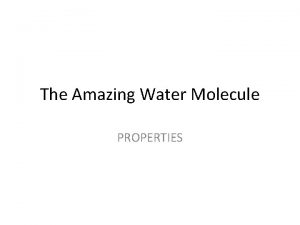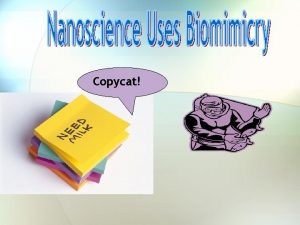Amazing Water Properties of Water Water has some

















- Slides: 17

Amazing Water Properties of Water

Water has some amazing, unique properties. • Polarity • Cohesion • Adhesion • Surface Tension • Density • Buoyancy • Specific Heat • Capillary Action • Universal Solvent

Water Molecule A water molecule (H 2 O)consist of 3 atoms: 2 hydrogen atoms and 1 oxygen atom. H O H

Polarity Water molecules have a slightly negative (-) charge near the oxygen atom and a slightly positive (+) charge near the hydrogen atoms. This uneven distribution of charges across the water molecule makes it polar The opposite poles of the water molecule attract each other and stick together. This property allows water to have so many unique properties! Water molecules act like a “magnet”

Cohesion Water molecules have a tendency to form weak bonds (hydrogen bonds) and stick together. Water is attracted to itself! One hydrogen bond is weak, but many hydrogen bonds are strong!

Surface tension happens when a force of Surface Tension attraction acts on the molecules at the surface of a liquid. Each water molecule is pulled in all directions by other molecules. The attractive forces are pulling downward and sideways causing the molecules at the surface to be held more tightly together forming a “skin” at the surface. Water striders can walk on water because of surface tension…which is a result of cohesion!

Adhesion is the tendency of water to stick to other substances. Water will make hydrogen bonds with other surfaces such as glass, soil, plant tissues, and cotton. Think of it this way. . . Adhesion is an attraction between two different substances. Water forms spheres and attach to plant leaves and spider webs…all because of adhesive properties!

Meniscus Adhesion causes a meniscus Concave and Convex • Water sticks to the sides of the glass • A – concave • B – convex

Cohesive Properties • Water sticks to water causing big droplets to ‘bead’ up Adhesive Properties • The formula reduces the ability of adhesion, causing the water to quickly slide off windshield

Density is the measure of mass per unit volume of a substance. • D = m/v • Density changes with temperature. Cold water is denser than warm water. If combined, the cold water would sink to the bottom of the warm water. • Density will change with physical state of matter. Ice is less dense than water. That means ice will float in water because ice expands when it freezes causing it to have a greater volume. • Water has a density of 1 g/m. L. Density Which is liquid water and which is ice (solid water)? How do you know the difference?


Buoyancy is the ability of a fluid to exert an upward force on an object that is immersed in the fluid. In other words…buoyancy is the ability for an object to float in a fluid! • All liquids exert an upward force, called buoyant force. If the buoyant force on an object is greater than the downward force (gravitational force), the object will float. A metal boat is able to float because its shape provides areas that can fill with air, which is less dense than water. The air helps lower the density of the boat, which allows the buoyant force of the water to keep the boat afloat.

So based on buoyant force, how does a submarine work? aley Se USS Sea ley USS Sealey

Specific Heat Specific heat is the amount of energy that is needed to raise 1 gram of a substance by 1 °C. Water has a high specific heat (4. 184 J/kg∙°C ). This is due to the strong attraction among water molecules. What does this mean? Water takes a long time to heat up and to cool down. Water resists temperature change. This property enables lakes, streams, and ocean ecosystems to maintain a stable temperature, even if the air temperature surrounding the body of water changes drastically. Have you ever wondered why the sand on the beach is hotter than the ocean water? Well, take a guess as to why the water is cooler than the sand…I will give you a hint, S_____ H______.

Capillary Action Capillary action is the combined forces of attraction among water molecules and the molecules of surrounding materials. Water molecules will “tow” each other along while in a tube. This property allows : • water to move through materials with pores inside • causes water molecules to cling to fibers in materials such as paper and cloth • water to rise in a straw/tube.

Water is the universal solvent Water dissolves more substances than any other known substance. A solvent is the substance in which another substance (solute) dissolves. Water’s polarity is the reason why water is such a good solvent. WHY? Water attracts and bonds with the ions in compounds. As you can see in the diagram, water molecules attract and forms bonds with the Na+ and Cl- ions in a crystal of salt. As the water pulls these ions into solution, the salt crystals dissolves.

 Homer has decided to buy a trampoline
Homer has decided to buy a trampoline Bart is able to buy 50 water balloons
Bart is able to buy 50 water balloons Water and water and water water
Water and water and water water Sometimes you win some
Sometimes you win some Sometimes you win some
Sometimes you win some Ice cream uncountable or countable
Ice cream uncountable or countable Force and motion
Force and motion Fire and ice diamante poem
Fire and ice diamante poem Some say the world will end in fire some say in ice
Some say the world will end in fire some say in ice Some trust in chariots and some in horses song
Some trust in chariots and some in horses song What are some chemical properties of matter
What are some chemical properties of matter Some properties of glass
Some properties of glass Descriptive matter
Descriptive matter Chemical property of matter
Chemical property of matter Implementation support
Implementation support What about today's class
What about today's class Austin's amazing bats
Austin's amazing bats Amazing aztecs
Amazing aztecs

































